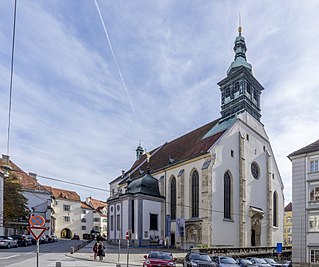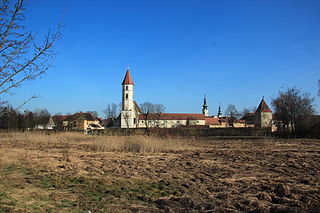
Ivančna Gorica is a settlement and a municipality in central Slovenia. It is part of the traditional region of Lower Carniola and is now included in the Central Slovenia Statistical Region.
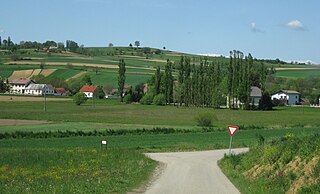
Sotina is a village in the Municipality of Rogašovci in the Prekmurje region of northeastern Slovenia. The village includes the following hamlets: Bezovkova Graba, Maribor, Bracov Dol, Činčov Breg, Kolarova Graba, Majcov Mlin, Martinova Graba, Patrov Breg, Tomanov Breg, and Turzov Breg.

Cven is a village in the Municipality of Ljutomer in eastern Slovenia. The area traditionally belonged to the Styria region and is now included in the Mura Statistical Region.

Grlava is a small village in the Municipality of Ljutomer in northeastern Slovenia. The area belongs to the traditional Styria region and is now included in the Mura Statistical Region.

Rinčetova Graba is a settlement in the hills southeast of Ljutomer in northeastern Slovenia. The area traditionally belonged to the Styria region and is now included in the Mura Statistical Region.

Šalinci is a settlement in the Municipality of Ljutomer in northeastern Slovenia. The area traditionally belonged to the Styria region and is now included in the Mura Statistical Region.

Železne Dveri is a settlement in the hills south of Ljutomer in northeastern Slovenia. The area traditionally belonged to the Styria region and is now included in the Mura Statistical Region.

Rodine is a settlement northwest of the town of Črnomelj in the area of White Carniola in southeastern Slovenia. It is part of the traditional region of Lower Carniola and is now included in the Southeast Slovenia Statistical Region.

Ručetna Vas is a settlement north of Črnomelj in the White Carniola area of southeastern Slovenia. The area is part of the traditional region of Lower Carniola and is now included in the Southeast Slovenia Statistical Region.
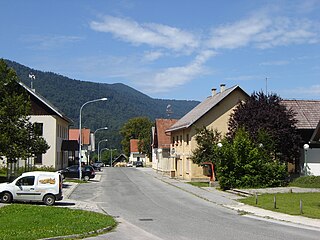
Kočevska Reka is a settlement in the Municipality of Kočevje in southern Slovenia. It was a village settled by Gottschee Germans. A major fire destroyed most of the village in 1929, but it was restored. During the Second World War its original population was expelled. The area is part of the traditional region of Lower Carniola and is now included in the Southeast Slovenia Statistical Region.

Mahovnik is a settlement on the left bank of the Rinža River, immediately northwest of the town of Kočevje in southern Slovenia. The area is part of the traditional region of Lower Carniola and is now included in the Southeast Slovenia Statistical Region.

Podgrad is a settlement east of the capital Ljubljana in central Slovenia. It belongs to the City Municipality of Ljubljana. It lies on the right bank of the Ljubljanica River at the entrance into the Besnica Valley. The Ljubljanica in turn flows into the Sava immediately northeast of the settlement core. The railway line from Ljubljana to Zidani Most runs through the settlement. The area was part of the traditional region of Lower Carniola and is now included with the rest of the municipality in the Central Slovenia Statistical Region.
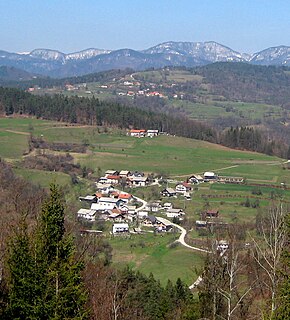
Vinje pri Moravčah is a small settlement in the Municipality of Moravče in central Slovenia. Traditionally the area was part of Upper Carniola. It is now included with the rest of the municipality in the Central Slovenia Statistical Region. The settlement includes the hamlet of Rožek.

Osojnik is a settlement north of Semič in southeastern Slovenia. Traditionally the area was part of Lower Carniola. The municipality is now included in the Southeast Slovenia Statistical Region.

Smrečnik is a remote abandoned settlement in the Municipality of Semič in southern Slovenia. The area is part of the traditional region of Lower Carniola and is now included in the Southeast Slovenia Statistical Region. Its territory is now part of the village of Komarna Vas.

Ovčjak is a remote abandoned settlement in the Municipality of Črnomelj in the White Carniola area of southeastern Slovenia. The area is part of the traditional region of Lower Carniola and is now included in the Southeast Slovenia Statistical Region. Its territory is now part of the village of Rožič Vrh.

The Municipality of Ljutomer is a municipality in northeastern Slovenia, some 40 kilometers (25 mi) east of Maribor. Traditionally it was part of the region of Styria. It is now included in the Mura Statistical Region. Its largest settlement and the administrative center is Ljutomer.

Dolenja Žaga is an abandoned settlement on the left bank of the Kolpa River north of Kostel in southern Slovenia. The area is part of the traditional region of Lower Carniola and is now included in the Southeast Slovenia Statistical Region. It includes the hamlets of Lobič, Na Rebri, and Trsje.

Gradec is a former settlement in the Municipality of Litija in central Slovenia. It is now part of the town of Litija. Traditionally the area was part of Styria and is now included with the rest of the municipality in the Central Sava Statistical Region.




